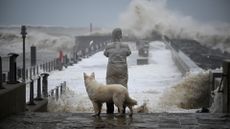Want to understand climate change? Look to the clouds.
Scientists are still uncovering the role clouds play in climate change


Scientists have long debated the role of clouds in climate change, with some arguing that they would make temperatures warmer while others arguing they might help cool the atmosphere. This is because clouds can both reflect sunlight and trap heat. “We have a really tough time simulating with any fidelity how clouds actually behave in the real world,” Timothy Myers, an atmospheric scientist at the University of Colorado, Boulder, told The Washington Post. However, experts have begun to uncover the influence clouds have on the climate.
How do clouds affect the climate?
Experts have found that clouds affect the climate in a variety of ways. Different cloud shapes play different roles in climate moderation. “Cirrus clouds — high, wispy clouds visible in the distant atmosphere on relatively clear days — absorb and trap more radiation, warming the Earth,” while “stratus or stratocumulus clouds — plump, fluffy clouds that often hover over the ocean on overcast days — reflect more sunlight, cooling the Earth,” per the Post.
Experts posit that clouds' role in climate change is greatly understated in most climate models. This is especially the case regarding warming temperatures in the Arctic, which have been increasing three to four times faster than the rest of the world. Polar-stratospheric clouds, also called mother-of-pearl clouds, are likely to blame for the faster warming. “Just like greenhouse gases, they absorb infrared radiation emitted by the Earth’s surface and re-emit a portion of this energy back to the surface,” the authors of a study analyzing the effect of the clouds, wrote in The Conversation. “And their effect could be significant, especially in winter, when the sun does not rise.”
Subscribe to The Week
Escape your echo chamber. Get the facts behind the news, plus analysis from multiple perspectives.

Sign up for The Week's Free Newsletters
From our morning news briefing to a weekly Good News Newsletter, get the best of The Week delivered directly to your inbox.
From our morning news briefing to a weekly Good News Newsletter, get the best of The Week delivered directly to your inbox.
The lack of data on clouds also translates to understating the impact of trees on the climate. Plants help cloud formation. “When plants emit gases that form aerosol particles (meaning particles suspended in the atmosphere), they help form cloud seeds,” NPR explained. “These particles can come from human pollution, or from natural sources like sea spray and dust.” As a result, “half of Earth’s cloud cover forms around stuff like sand, salt, soot, smoke, and dust,” while “the other half nucleates around vapors released by living things or machines, like the sulfur dioxide that arises from burning fossil fuels,” per Wired.
What researchers do know is that “clouds are so influential on the Earth’s climate already,” and “even small changes in clouds as the world warms can have large effects on future temperature change,” per the Post.
What are the worries?
While clouds can contribute to climate change, cloud formation is also affected by climate change. As the Earth warms, clouds become scarcer. “With fewer white surfaces reflecting sunlight back to space, the Earth gets even warmer, leading to more cloud loss,” Wired wrote. “This feedback loop causes warming to spiral out of control.” Specifically, the disappearance of the fluffy stratocumulus clouds could inhibit some of the Earth’s ability to reflect sunlight back and cool itself, causing the climate to go “over a cliff,” Kerry Emanuel, a climate scientist at the Massachusetts Institute of Technology, told the outlet.
Numerous models have depicted scenarios of warming due to human activity. However, those taking into account cloud cover show a variety of potential outcomes with some less sensitive models showing two degrees Celsius of warming over pre-industrial levels and some of the more sensitive models going as high as four or five degrees. “The thing that really freaks people out is this upper end here,” Kate Marvel of the NASA Goddard Institute for Space Studies, told Wired. “To put that in context, the difference between now and the last ice age was 4.5 degrees.”

Continue reading for free
We hope you're enjoying The Week's refreshingly open-minded journalism.
Subscribed to The Week? Register your account with the same email as your subscription.
Sign up to our 10 Things You Need to Know Today newsletter
A free daily digest of the biggest news stories of the day - and the best features from our website
Devika Rao has worked as a staff writer at The Week since 2022, covering science, the environment, climate and business. She previously worked as a policy associate for a nonprofit organization advocating for environmental action from a business perspective.
-
 5 X-plosive cartoons about Elon Musk
5 X-plosive cartoons about Elon MuskCartoons Artists take on his proposed clean-up of X, his views on advertisers, and more
By The Week US Published
-
 2023: the year of superhero fatigue
2023: the year of superhero fatigueThe Explainer The year may represent the end of an era for Hollywood
By Brendan Morrow, The Week US Published
-
 Recipe: roast garlic mushrooms with parsley and eggs by Gelf Alderson
Recipe: roast garlic mushrooms with parsley and eggs by Gelf AldersonThe Week Recommends A simple and classic breakfast combination
By The Week UK Published
-
 Places that will become climate refuges
Places that will become climate refugesThe Explainer The Midwest may become the new hotspot to move
By Devika Rao, The Week US Published
-
 A23a: why world's biggest iceberg is on the move
A23a: why world's biggest iceberg is on the moveThe Explainer The mass of ice is four times the size of New York and 'essentially' an island
By Chas Newkey-Burden, The Week UK Published
-
 Cop28: is UAE the right host for the climate summit?
Cop28: is UAE the right host for the climate summit?Today's Big Question Middle East nation is accused of 'pushing for a green world that can still have its oil'
By Chas Newkey-Burden, The Week UK Published
-
 Scientists have their eyes on 2 supervolcanoes
Scientists have their eyes on 2 supervolcanoesThe Explainer 'The probability of a catastrophic eruption is low but not nil'
By Devika Rao, The Week US Published
-
 6 looming climate tipping points that imperil our planet
6 looming climate tipping points that imperil our planetThe Explainer A UN report details the thresholds we may be close to crossing
By Devika Rao, The Week US Published
-
 'Danger to life' warning as Storm Ciarán hits UK shores
'Danger to life' warning as Storm Ciarán hits UK shoresSpeed Read Schools closed and train, plane and car travel disrupted as Met Office issues weather warnings
By The Week UK Published
-
 The drying Amazon rainforest: a drought that affects the world
The drying Amazon rainforest: a drought that affects the worldUnder the radar The Amazon is suffering a drought of historic severity and it’s pushing its inhabitants to their limit
By The Week UK Published
-
 Under Antarctic ice lies a hidden landscape
Under Antarctic ice lies a hidden landscapeSpeed Read Climate change may reveal it over time
By Devika Rao, The Week US Published










